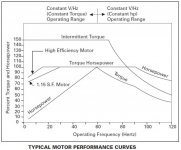gavingear
Aluminum
- Joined
- Apr 24, 2008
- Location
- Cashmere, Washington
Hello all- I have a bridgeport-style milling machine with head similar to J-Head, but without back gearing.
The current motor on the machine is 1750 RPM 120/240 single phase, and I want to go with a variable speed setup using VFD and 3-phase motor (have done a lot of reading on this site on that in general).
My question is- if I go with a 3450 2-pole 3-phase motor (there's one available locally) - what RPM can I expect it to run down to with reasonable torque? When using a VFD, does the rated RPM have the same effect/meaning compared to being used without a VFD? (meaning same frequency, etc - are the RPMs double that of a 3-phase 4-pole setup that's rated for 1750 RPM).
Any general thoughts would be helpful, this will be my first VFD setup!
The current motor on the machine is 1750 RPM 120/240 single phase, and I want to go with a variable speed setup using VFD and 3-phase motor (have done a lot of reading on this site on that in general).
My question is- if I go with a 3450 2-pole 3-phase motor (there's one available locally) - what RPM can I expect it to run down to with reasonable torque? When using a VFD, does the rated RPM have the same effect/meaning compared to being used without a VFD? (meaning same frequency, etc - are the RPMs double that of a 3-phase 4-pole setup that's rated for 1750 RPM).
Any general thoughts would be helpful, this will be my first VFD setup!





